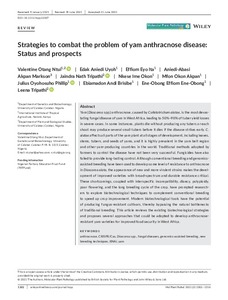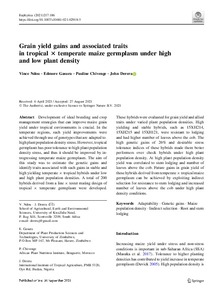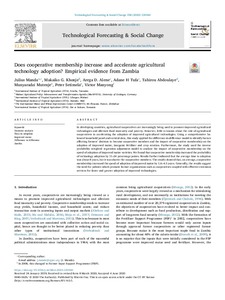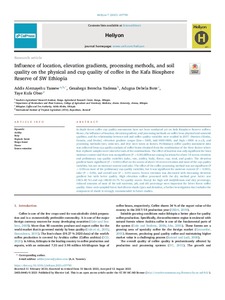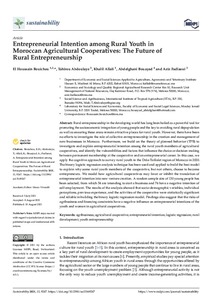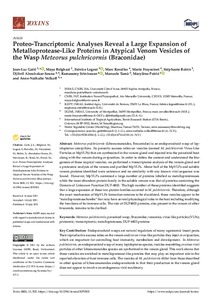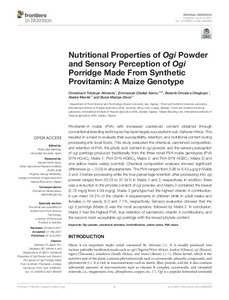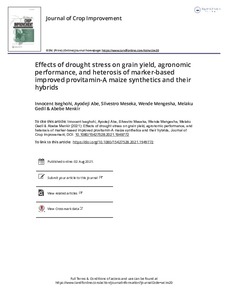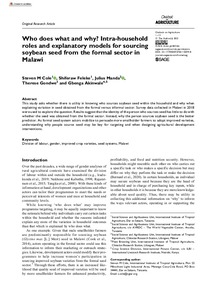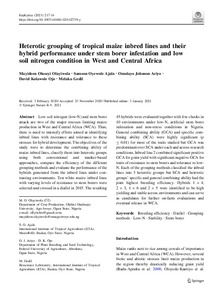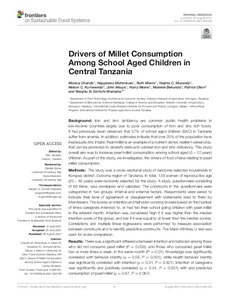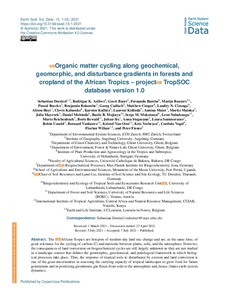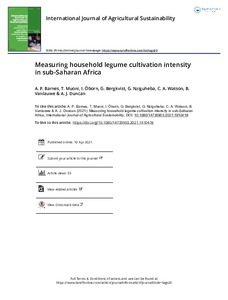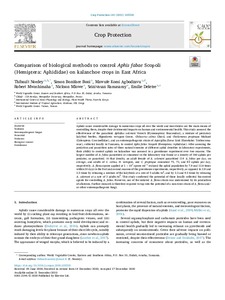Welcome to the International Institute of Tropical Agriculture Research Repository
Journal and Journal Articles: Recent submissions
Now showing items 881-900 of 5157
-
Strategies to combat the problem of yam anthracnose disease: status and prospects
(2021-10)Yam (Dioscorea spp.) anthracnose, caused by Colletotrichum alatae, is the most devastating fungal disease of yam in West Africa, leading to 50%–90% of tuber yield losses in severe cases. In some instances, plants die without producing any tubers or each shoot may produce several small tubers before it dies if the disease strikes early. C. alatae affects all parts of the yam plant at all stages of development, including leaves, stems, tubers, and seeds of yams, and it is highly prevalent in the yam ... -
Integrating the soybean‑maize‑chicken value chains to attain nutritious diets in Tanzania
(2021)In Tanzania, diets are dominated by starchy staple crops such as maize, levels of malnutrition are high and largely attributed to lack of dietary diversity. We employed fuzzy cognitive mapping to understand the current soybean, maize and chicken value chains, to highlight stakeholder relationships and to identify entry points for value chain integration to support nutritious diets in Tanzania. The fuzzy cognitive maps were constructed based on information gathered during household interviews with ... -
Grain yield gains and associated traits in tropical x temperate maize germplasm under high and low plant density
(2021-09)Development of ideal breeding and crop management strategies that can improve maize grain yield under tropical environments is crucial. In the temperate regions, such yield improvements were achieved through use of genotypes that adapt high plant population density stress. However, tropical germplasm has poor tolerance to high plant population density stress, and thus it should be improved by temperate maize. The aim of this study was to estimate the genetic gains and identify traits associated ... -
Does cooperative membership increase and accelerate agricultural technology adoption? Empirical evidence from Zambia
(2020)In developing countries, agricultural cooperatives are increasingly being used to promote improved agricultural technologies and alleviate food insecurity and poverty. However, little is known about the role of agricultural cooperatives in accelerating the adoption of improved agricultural technologies. Using a comprehensive balanced household panel and varietal data, this study applied the difference-in-difference model to identify factors affecting farmers’ decision to become cooperative members ... -
Influence of location, elevation gradients, processing methods, and soil quality on the physical and cup quality of coffee in the Kafa Biosphere Reserve of SW Ethiopia
(2021-08)In-depth forest coffee cup quality assessments have not been conducted yet on Kafa Biosphere Reserve coffees. Hence, the influence of location, elevation gradient, and processing methods on coffee bean physical and sensorial qualities, and the relationship between soil and coffee quality variables were studied in 2017. Districts (Gimbo, Gawata, and Decha), elevation gradient ranges (low-<1600, mid-1600-1800, and high->1800 m a.s.l), and processing methods (wet, semi-wet, and dry) were taken as ... -
Entrepreneurial intention among rural youth in Moroccan Agricultural Cooperatives: the future of rural entrepreneurship
(2021)Rural entrepreneurship in the developing world has long been hailed as a powerful tool for promoting the socioeconomic integration of young people and the key to avoiding rural depopulation as well as ensuring these areas remain attractive places for rural youth. However, there have been no efforts to investigate the role of collective entrepreneurship in the creation and management of new businesses in Morocco. Furthermore, we build on the theory of planned behavior (TPB) to investigate and explain ... -
Life cycle assessment of animal-based foods and plant-based protein-rich alternatives: an environmental perspective
(2021)BACKGROUND In the European Union proteins for food are largely animal based, consisting of meat and dairy products. Almost all soy but also a larger part of pulses and cereals consumed in the European Union are used for animal nutrition. While livestock is an important source of proteins, it also creates substantial environmental impacts. The food and feed system is closely linked to the planetary and health boundaries and a transformation to healthy diets will require substantial dietary shifts ... -
Agro-morphological characterization of Arabica coffee cultivars in Burundi
(2021)Background and Objective: Arabica coffee is an important beverage crop in world trade. The crop is gaining increasing importance in Burundi as an export crop. This study aimed to evaluate diversity among coffee cultivars based on quantitative agro-morphological traits for developing superior cultivars in Burundi. Materials and Methods: Fifteen coffee accessions including five commercial cultivars) were used in the study. From each accession, data were collected from three randomly selected trees ... -
Proteo-trancriptomic analyses reveal a large expansion of metalloprotease-like proteins in atypical venom vesicles of the wasp Meteorus pulchricornis (Braconidae)
(2021-07-19)Meteorus pulchricornis (Ichneumonoidea, Braconidae) is an endoparasitoid wasp of lepidopteran caterpillars. Its parasitic success relies on vesicles (named M. pulchricornis Virus-Like Particles or MpVLPs) that are synthesized in the venom gland and injected into the parasitoid host along with the venom during oviposition. In order to define the content and understand the biogenesis of these atypical vesicles, we performed a transcriptome analysis of the venom gland and a proteomic analysis of the ... -
Nutritional properties of ogi powder and sensory perception of ogi porridge made from synthetic provitamin: A maize genotype
(2021)Provitamin-A maize (PVA) with increased carotenoid content obtained through conventional breeding techniques has been largely successful in sub-Saharan Africa. This resulted in a need to evaluate their susceptibility, retention, and nutritional content during processing into local foods. This study evaluated the chemical, carotenoid composition, and retention of PVA, the phytic acid content in ogi powder, and the sensory perception of ogi porridge produced traditionally from the three novel PVA ... -
Reproduction potential of Nigerian Meloidogyne spp. and the response of six commercial watermelon cultivars to predominant species
(2021)The reproduction potential of nine single-species Meloidogyne populations and 16 mixed-species communities, recovered from watermelon rhizospheres in South-West Nigeria, were determined in roots of tomato (cv. Tropimech) in a glasshouse. The host responses of six commercial watermelon cultivars were also assessed under glasshouse conditions to single-species populations of Meloidogyne incognita, M. javanica and M. enterolobii. Reproduction potential of different Meloidogyne populations and the ... -
Effects of drought stress on grain yield, agronomic performance, and heterosis of marker-based improved provitamin-A maize synthetics and their hybrids
(2021)Provitamin A-enriched maize (Zea mays L.) is an important complementary food staple for combating vitamin A deficiency (VAD) in high maize-producing and maize-consuming countries of sub-Saharan Africa (SSA). However, frequent drought is a major abiotic factor that retards maize growth, resulting in yearly fluctuations in grain yield. Development of provitamin A-enriched maize varieties resilient to recurrent drought stress could enhance and stabilize maize grain yield. This study was conducted to ... -
Understanding nutrient imbalances in maize (Zea mays L.) using the diagnosis and recommendation integrated system
(2021)Low nutrient use efficiency in maize as a result of imbalanced nutrition has been reported to drastically reduce yield. We implemented a nutrient omission experiment to assess the effect of nutrient application on maize yield and nutritional balance. Maize ear leaves were analyzed for nutrients, to identify nutrient balance status using the Diagnostic and Recommendation Integrated System (DRIS) approach. Results indicated that omission of N or P resulted in highly imbalanced DRIS indices respectively, ... -
Who does what and why? Intra-household roles and explanatory models for sourcing soybean seed from the formal sector in Malawi
(2021-08-02)This study asks whether there is utility in knowing who sources soybean seed within the household and why when explaining variation in seed obtained from the formal versus informal sector. Survey data collected in Malawi in 2018 were used to explore the question. Results suggest that the identity of the person who sources seed has little to do with whether the seed was obtained from the formal sector. Instead, why the person sources soybean seed is the better predictor. As formal seed system actors ... -
Heterotic grouping of tropical maize inbred lines and their hybrid performance under stem borer infestation and low soil nitrogen condition in west and central Africa
(2021)Low soil nitrogen (low-N) and stem borer attack are two of the major stresses limiting maize production in West and Central Africa (WCA). Thus, there is need to intensify efforts aimed at identifying inbred lines with resistance and tolerance to these stresses for hybrid development. The objectives of the study were to determine the combining ability of maize inbred lines, classify them into heterotic groups using both conventional and marker-based approaches, compare the efficiency of the different ... -
Drivers of millet consumption among school aged children in central Tanzania
(2021)Background: Iron and zinc deficiency are common public health problems in low-income countries largely due to poor consumption of iron and zinc rich foods. It has previously been observed that 57% of school aged children (SAC) in Tanzania suffer from anemia. In addition, estimates indicate that over 25% of the population have inadequate zinc intake. Pearlmillet is an example of a nutrient dense, resilient cereal crop, that can be promoted to diversify diets and combat iron and zinc deficiency. ... -
Organic matter cycling along geochemical, geomorphic and disturbance gradients in forests and cropland of the African Tropics - project TropSOC database version 1.0
(2021)The African Tropics are hotspots of modern-day land-use change and are, at the same time, of great relevance for the cycling of carbon (C) and nutrients between plants, soils and the atmosphere. However, the consequences of land conversion on biogeochemical cycles are still largely unknown as they are not studied in a landscape context that defines the geomorphic, geochemically and pedological framework in which biological processes take place. Thus, the response of tropical soils to disturbance ... -
Measuring household legume cultivation intensity in sub-Saharan Africa
(2021)Legumes form part of an ecological-based solution to intensification in areas with limited access to external inputs. Despite a number of decades of intervention, uptake of legumes has been slow within smallholder farming systems in sub-Saharan Africa. We explore the drivers behind the adoption of legumes by developing an indicator of household legume cultivation (HLC) from a bespoke survey of small-scale farm households in Kenya and the Democratic Republic of the Congo. A beta regression framework ... -
Comparison of biological methods to control Aphis fabae Scopoli (Hemiptera: Aphididae) on kalanchoe crops in East Africa
(2021)Aphids cause considerable damage to numerous crops all over the world and insecticides are the main means of controlling them, despite their detrimental impacts on human and environmental health. This study assessed the effectiveness of the parasitoid Aphidius colemani Viereck (Hymenoptera: Braconidae), a mixture of predatory ladybird beetles, Hippodamia variegata Goeze, Chilocorus calvus Chiccl, and Cheilomenes propinqua Mulsant (Coleoptera: Coccinellidae), and an entomopathogenic strain of ...

